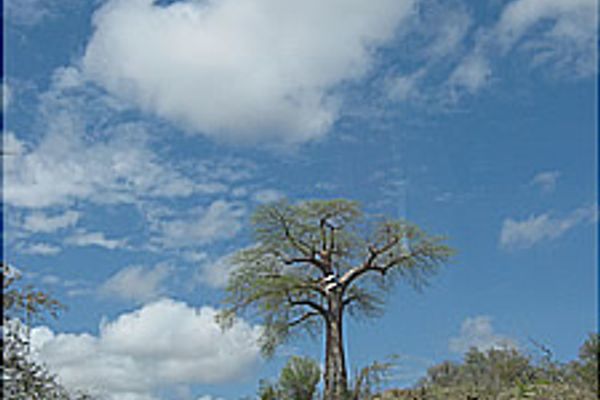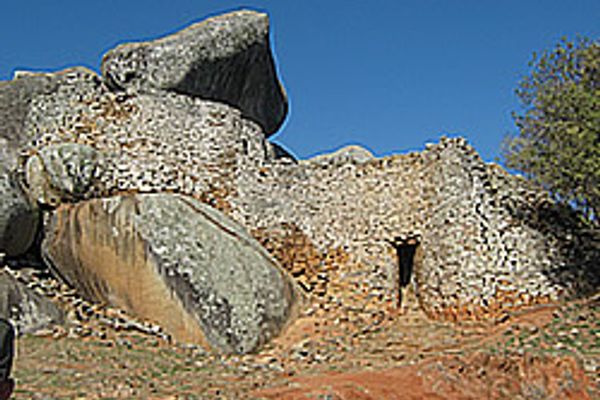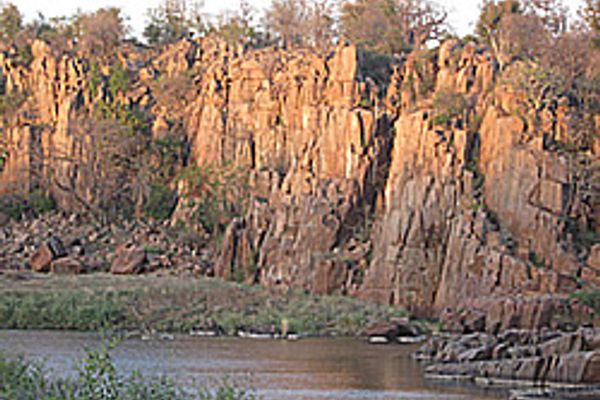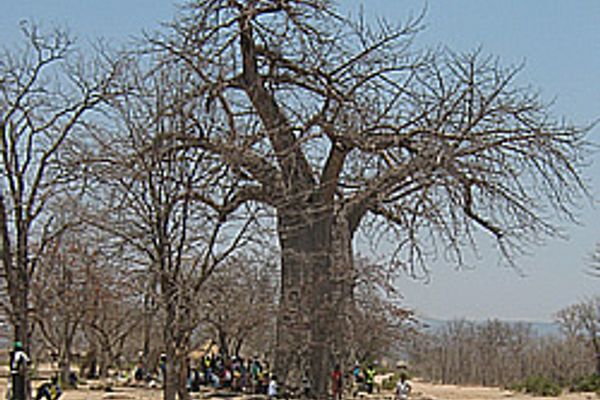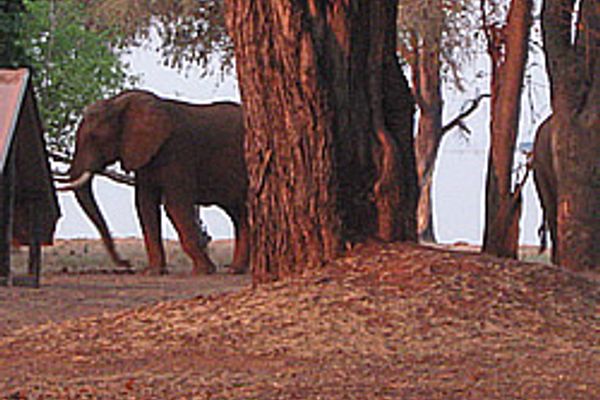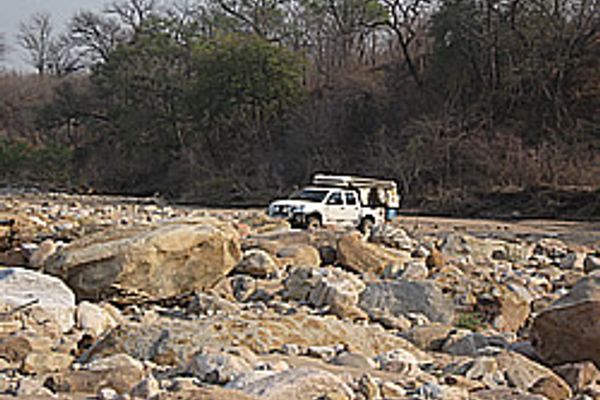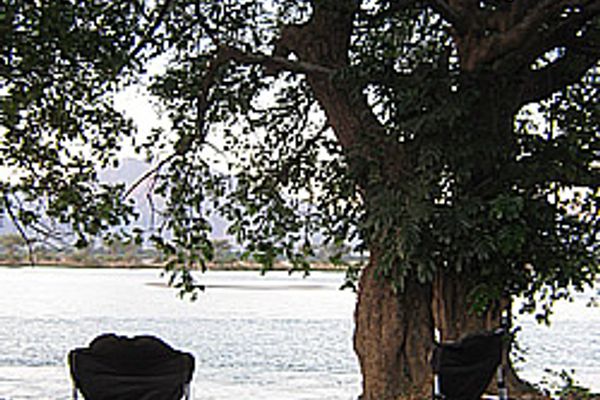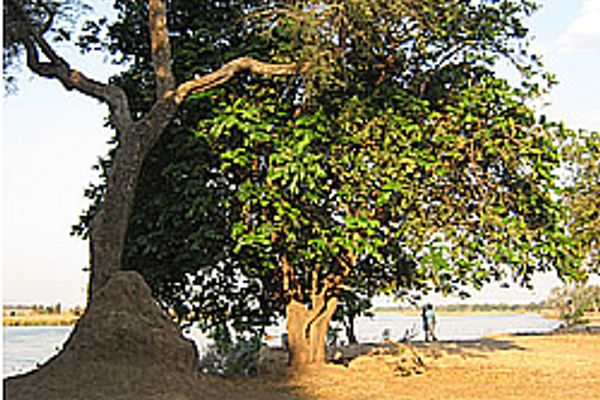
About Zimbabwe: Gonarezhou National Park
About Zimbabwe
Gonarezhou National Park
Our first destination, where we camped at Chipinda Pools and ChilojoCliffs, is becoming more and more popular with travellers to Zimbabwe.
At first, I was puzzled by the absence of animals. The word ‘park’ is actually a misnomer, as the land set aside is vast, the size of a European country. Since there are no fences, the animals can wander at will and not be seen for ages. From Zimbabwe to Mozambique to the Kruger and back, and viewing roads are few and far between, more like tracks through the bush. One bumps along, swaying to the left and right, and apprehends the most natural, unspoiled country. Masses of baobabs, many young and green like one doesn’t see even in the Kruger. Wonderful landscapes, but how do they market this national park where you are unlikely to see animals? Do people travel to see vistas? Wide open spaces?
Four-by- four Routes
Our route started at Punda Maria in the Kruger Park. We entered Mozambique at the Pafuri Gate, crossed the almost dry Limpopo River and hugged the border till we reached the Sango Gate, where weentered Zimbabwe. This is a 4/4 route, and not advisable to do alone as it is remote and we found the Mozambicans unfriendly.
Great Zimbabwe Ruins
We headed next to Masvingo and the Zimbabwean Ruins, reached viathe A10 and A4 roads. Between Gonarezhou Park and the Zimbabwean Ruins, quite a distance, the scenery remains amazing; trees, trees and more trees…enormous hardwoods...tambotie, wild olive, mopane, African teak. Massive granite outcrops all over the place…with scattered huts beneath.
About this time too, we started to see our first people. Another misconception corrected. I arrived in Zimbabwe with quite a few. I expected hostility, some personal concern for safety, but this expectation changed when we passed our first groups on the road, and all to a man, were friendly, waving as we passed. In the villages, everyone was polite, well mannered, and helpful. It was a pleasure. Faces were open and pleasant, body language assured and relaxed.
We travelled mostly in rural areas, and right around the country. Poverty was apparent, but so too was dignity, cleanliness and composure. I was amazed at the bright, clean colours worn by the people. So few resources, yet they were neat - the school children a delight in basic uniforms. Schools proliferated all over between villages. I didn’t see slums as one has in S.A., except very basic and crowded housing outside of Bulawayo. In the countryside, mud and straw huts are the norm.
Bribes?
I had heard about soldiers stopping you on the road, demanding money. For this reason I wouldn’t consider going there without a guide. There were many stops on the road, most of them toll gates where everything was ordered, and a dollar toll was paid. Other stops by road traffic police were carried out in a controlled fashion. Our papers were checked, cars, driver’s licenses etc, but no incidents occurred.
Let me mention that in Zim., you are expected to obey the speed limit, indeed, to obey every rule of the road. There are countless numbers of police and traffic officials about, making sure that you do. If the speed limit says 60, you do 60…and at once.
The only bribe we were asked for was at the entrance into Zim. at the remote border post from Mozambique, and my husband parted with R100. He thought it was the better part of valour. Our guide exercised every caution to make sure that everything went well. Check everything....Yes, you did see the official stamping the counter loud and clear, but did he actually stamp your passport. Take nothing for granted. Be friendly, relaxed and calm...and refuse to pay bribes.
Mana Pools
Our next destination was the world famous Mana Pools. To get there we took the A4 to Harare and then turned off onto the A1 to Mana Pools, stopping at Karoi to stock up on provisions.
At Mana Pools we camped right next to the Zambezi...the river was lovely. I especially liked the view of the hills in Zambia just across the river...and the elephants wandering around in the marshes exactly as when Livingstone floated down this way in his makoro.
Provisions
Only American dollars are used in Zim. Apparently one can withdraw from ATM’s but should have cash as a standby, as they might not be operational. We carried spare diesel but did not use it. It has happened that petrol stations in the main centres on route are dry.
We were stocked up with South African dry food, and this is a good precaution. There are big stores such as OK Bazaars in the main centres, but we struggled to get decent meat to braai. In the smaller centres, the situation is less certain. Sometimes, you can’t get bottled water, so best to take lots of this. It is not like Botswana, where there is a well-stocked Spar in every town.
The very remote Tashinga Camp
The next day we braved the 4/4 route to Tashinga Camp in the Matusadona National Park, a nightmare experience. Not all our cars made it through this road unscathed and at one point we were even thinking of stopping and camping alongside the road. Unbeknown to us at the time, the occupants in the lead car had seen about nine adult lions walking across the road and disappearing into the bush…so we would have had company should we have camped there.
It was so hot at Tashinga Camp, one felt one could expire from the heat...and we looked at the blue water of Lake Kariba longingly...but the caretaker said ‘NO! NO! NO SWIMMING….BIG CROCODILES !’.
We went for a walk along the edge of the lake being careful not to stray too close to the edge. We saw snake spoor, the pug marks of lions and elephant holes. We were too nervous to walk past the approaching bush. Maybe there was something in there.
In all the camps there were no fences and in this camp, elephants wandered in along their usual route whether we were camped there or not. One stamped the dust and swayed and waved her ears and shrieked when Piet came out of the shower area unexpectedly, wearing his shorty pyjamas.
At this camp, a year before, a visitor, in his cups, refused to sleep in his tent...and he lost half his face to a lion. He had to be airlifted out. The caretaker had done his best to get him into a tent.
Binga on Lake Kariba
Instead of going straight to Hwange the next day we went to Binga, a closer destination as we were feeling the heat and the pace of the itinery. Binga has all the human comforts in a hot climate....sunset cruises, pools, hotels etc. We all swam in the pool as it was suicide not to swim in that October heat.
Many people love the Kariba, for boating and fishing...especially house boat holidays. I am sure this is very nice, but one is confined to the boat...though the views will be amazing.
The town of Binga on the Kariba appears on the map as a large promising dot, but there is almost nothing to be bought. You can ask the shop owner if he has some meat for you. We did, and they produced a fillet from the back of the shop...and very nice it was.
Health
Chris, our guide, was very careful about health, especially since he is the leader. Never buy cooked food he said. He doesn’t even buy a bread roll in an African country. Of course, he has a fridge and freezer on board, and carries rolls from SA.
This is going to extremes, but I also wouldn’t buy cooked food in the small towns, only dry and tinned food. He was very cautious as well about handling the dollars that have been in circulation for so long. At the toll stops where they charge a dollar, you may get four well fingered, dirty dollars back for your five dollars.
Our group
While all the above observations were taking place, they occurred, despite the culture of the travelling group. We were six cars, one for the guide and another for a lone male traveller, and four couples in the other cars. Two of the couples related, brothers, and the lone traveller was their friend...so a party of five created the dominant culture in the group. And they had a very distinct way of travelling and camping, quite different to ours. Ours was based on the simplest and most basic camp life, the simplest and quickest meals. No frills. Theirs was based on a culture of ladies doing what well brought up Afrikaans speaking ladies are known to do ; look after their men.
No sooner had we stopped for the night when tables were set up, table cloths produced, and all manner of civilised amenities were laid out. Snacks, drinks etc. A braai did not consist of meat and rolls or meat and baked beans as in our camp just next door. A braai consisted of meat, stywe pap, tomatie smoor, corn and a variety of vegetables. Pudding as well. All these dishes were washed under difficult circumstances, dried and packed away.
The men were Piet and Hennie. Hennie, from the start, was dressed to kill; a buff around his neck, a fancy cap, even fancier sunglasses, top of the range clothing. His car looked the same. Too much stuff. Every surface carried something , useful or otherwise. He bragged about his car, and everyone admired it, a travelling home on wheels, a tent on top and a place for everything. Much of this came undone over the days.
Piet too, had a brand new top of the range car. They towed a new trailer with a tent that unfolded like a home from home. Since this is big 4 by 4 country there is always talk about cars. The men could find nothing to say about the Toyota. They did say from time to time ‘ag, gee vir hom‘n bier. Shame, hy ry die hele dag in ‘n Toyota,’ referring to my husband.
Hwange Park
I looked forward to our last stop at Hwange Park, the former Wankie…it was world famous, was it not? Animals galore will surely be there. But my education was not complete. I hadn’t been paying attention. We arrived at the end of October, there was no water anywhere. There were no animals seen after hours of driving in the park. Bare stripped trees, long yellow grass, heat…the guide reminded me that Hwange, Chobe and areas of Zambia were now all considered one park. The animals could be over in Botswana when I visited. This is no canned area, no guaranteed sightings. This is what he likes about it.
We slept over at a hide in Hwange. At this last camp in Hwange, we had no water, no electricity and we used a bush shower. A bag was suspended from a tree that overhung an iron cubicle with a permanently open door. When ready to shower one released the water, cold of course, and showered as long as it lasted. Towards the end, one got dirtier and dirtier. Dirt became a relative thing. Dirtier than yesterday, or the day before....which now looked relatively clean.
The water hole was large and during the course of the night many dark silent forms moved down to the water, maybe hundreds. The night air was torn by loud trumpeting and splashing. Trumpeting does not begin to describe the volume of sound a large angry elephant can produce. It almost sounds like the sound barrier breaking.
Lions roared in the near distance. The last thing my husband said that night was, ‘did you hear that? Is it a lion?’ he was referring to a low gurgle close to the tent. I went to sleep, knowing it was the rumble of elephants. We were open to the elements, only the trusted zip and gauze protecting us from predators out there.
Good bye, beautiful land
When I think of Zimbabwe, I think of moving within vast volumes of space. One leaves the country with a new apprehension of space, the scale of everything astonishes …the height of the trees, the sweep of uninterrupted views, with absolutely no fences or pylons or man-made obstructions to piece up the view. Also the skies, a luminous blue that goes up and up. It stays in one’s awareness.
Home
Arriving back in SA, at Musina, the familiar dirty streets, and crowded sidewalks and loud, in your face behaviour made us wary again. Saturday morning in South Africa!
If you go, you need to know:
There are plenty of rules for cars, such as triangles etc that you can access on the internet. Border-crossing into Zim. costs about R700, payable in US dollars. Make sure all your lights are functioning. You need paperwork for the car, proving that it is yours.
If you are planning a trip, just choose your spots on the map, stick to the tar roads and you will have a wonderful time. Zim. Falls is of course very tourist friendly. They take dollars, and Rands etc. You will find everything you need there.
If you go on to Chobe in Botswana, which many people do, you may need a 4/4 to get around in the Park, but you can stay at the famous Chobe River lodges in Kasane. Everything can be arranged for you, river cruises and game drives.
Last point, camouflage clothing is illegal in Zim. Also, trucks will indicate with their left indicator if it is safe to pass, a right indicator means unsafe, the opposite of S.A.
A road sign with an ‘x’ on it means that the speed limit is cancelled, and the previous speed applies.
In short, planning trips on tarred roads and staying at reputable lodges or hotels will be no bother at all and perfectly safe. These places will also arrange game viewing or river cruises.
Happy Travelling!
Jean Baker
Art and Travel @ 22 The Hope
Cape St Francis
About Zimbabwe
